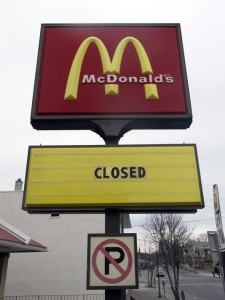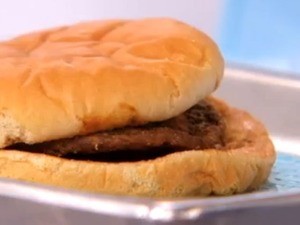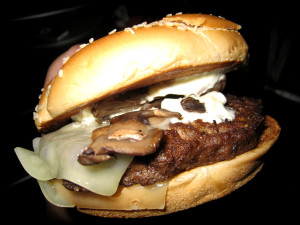I stood and stared at it for what felt like three minutes. I’m sure it was actually less, but the fact that nothing was happening had the effect of stretching time. All the bits were there, but that’s circumstantial. For illustration, a man with ten fingers is perfectly normal. A man with seven on one hand and three on the other — not so much.
And it was very much the same here. The arches: still golden. The drive-thru still had its awning over the serving window. But the arches weren’t lit and no one was at the drive-thru, inside or out. Seeing a McDonalds closed for business is a disorienting thing.
 I am morbidly prone to over-sentimentality, but not for fast food chains. I’ve been off the fast food joints for a couple of years, with only the occasional lapse and almost always with regret. If you do not eat one of these burgers for a long period of time and then break the fast and eat one, you’ll taste only one thing above all. That’s salt. Lots of it.
I am morbidly prone to over-sentimentality, but not for fast food chains. I’ve been off the fast food joints for a couple of years, with only the occasional lapse and almost always with regret. If you do not eat one of these burgers for a long period of time and then break the fast and eat one, you’ll taste only one thing above all. That’s salt. Lots of it.
These chains survive more on nostalgia than the food anyhow. You go to these places because of pleasant associations from the past; associations time has now rendered impossible. The other attributes that once recommended these businesses have slowly been winnowed away over time. The “cheap food” aspect is particularly galling when you try to square the circle that is a ten dollar “value meal.” While no one would have ever dared call fast food “quality,” even out of sarcasm, there was a guilty tastiness to the stuff that caused people to go back, even though a lot of those trips were for “hate-eating” purposes.
Large parts of McDonalds’ income have evaporated not solely because of the sit-down eateries like the Chili’s, Outbacks, or Friday’s of the world, although many business pundits would have you believe that is the only course. I’ve seen many more of those previously mentioned franchise eateries go out before even the most haggard Mickey D’s. The closure rates for Burger Kings’ and Wendys’ are fairly high too, and so seeing their shopfronts vacated, while being jarring, is not altogether foreign.
So what exactly is causing the standard-bearer for franchise businesses to buckle?
 I alluded to part of it already. “Hate-eating” or “stress-eating” or any other act of feeding oneself in the attempt to feel better about something, rather than for the innate purposes of satiety, is a huge problem. It often manifests itself in the purchasers with a fair level of guilt and shame, and so these folks will often be found buying the food from the drive-thru rather than having the possibility of judgment for poor choices weighed down by being inside the storefront. They will take the food and, rather than go home, will drive to the back of the parking lot and eat in the car, depositing the trash there, not taking it home where that same judgment can still be levied.
I alluded to part of it already. “Hate-eating” or “stress-eating” or any other act of feeding oneself in the attempt to feel better about something, rather than for the innate purposes of satiety, is a huge problem. It often manifests itself in the purchasers with a fair level of guilt and shame, and so these folks will often be found buying the food from the drive-thru rather than having the possibility of judgment for poor choices weighed down by being inside the storefront. They will take the food and, rather than go home, will drive to the back of the parking lot and eat in the car, depositing the trash there, not taking it home where that same judgment can still be levied.
With the increase of choice at convenience stores, you can get mozzarella sticks, sandwiches, chicken nuggets and all manner of not-so-good-for-you items, usually for much cheaper prices. Because everyone has to go inside, there’s a shared burden of guilt and, if everyone has it, no one has it. Further, price has little to do with it, considering the cost of a “venti-sized” coffee from Starbucks, still a successful seller.
None of this is really health-related. The rates of obesity among American adults is still frighteningly high, as are the instances of heart disease and diabetes.
 McDonalds has tried several ploys to lure back marketshare, including an ill-fated concept of serving their breakfast items all day long. On its face it is a brilliant idea. In any random poll, numbers highly indicate that people are more likely to want eggs, bacon, sausage and/or pancakes for dinner than having a Big Mac for breakfast. The former simply seems like a viable choice whereas the latter seems sad and depressing. What McD’s failed to reckon is that if people are inclined to have breakfast for dinner, they’ll go to a place that has been providing these for years: your IHOPs, Dennys, Perkins and so forth. Plus, Starbucks has been offering breakfast-style pastries with the coffee since the beginning, and that encroachment led to the inception of the McCafe coffee rollout that, briefly, buoyed McD’s sagging bottom line. Rather than suddenly filling a presumed void, they were only horning in on a business region others staked a claim to decades before.
McDonalds has tried several ploys to lure back marketshare, including an ill-fated concept of serving their breakfast items all day long. On its face it is a brilliant idea. In any random poll, numbers highly indicate that people are more likely to want eggs, bacon, sausage and/or pancakes for dinner than having a Big Mac for breakfast. The former simply seems like a viable choice whereas the latter seems sad and depressing. What McD’s failed to reckon is that if people are inclined to have breakfast for dinner, they’ll go to a place that has been providing these for years: your IHOPs, Dennys, Perkins and so forth. Plus, Starbucks has been offering breakfast-style pastries with the coffee since the beginning, and that encroachment led to the inception of the McCafe coffee rollout that, briefly, buoyed McD’s sagging bottom line. Rather than suddenly filling a presumed void, they were only horning in on a business region others staked a claim to decades before.
McD isn’t the only one in need of a gimmick. In the fall of 2015, Burger King introduced the Halloween Whopper. The rolls were made with black-tinted dough, the coloration provided by A-1 Steak Sauce. The same was true for the black-tinted cheese. With all of the absence of color involved, it is only justifiable that those who ate the burgers would be alarmed when their feces came out as neon green (perhaps the shade of a McDonalds Shamrock Shake).
There’s also a growing distrust of whether the food itself is safe. In February, it was reported that the corporation suffered a $300 million net loss as Japanese locations plummeted for precisely that reason. They were scandalized when, in 2014, video surfaced of mishandled meat, and the usage of out-of-date meat, and the appearance of indigestible substances in the nuggets, presumed to be bits of vinyl. Anyone who has studied the sharp reversal of fortunes suffered by upstart Chipotle Mexican Grill — once believed to be a real Ronald McDonald slayer in waiting — knows how quickly the public can turn on you. Chipotle initially put down its roots with buzzwords like “organic” and “fresh” and “no GMOs”, claims that McD’s have only glancingly scraped past in its history. The presumed betrayal from Chipotle for the rash of e-coli outbursts could not parallel McDonalds because they never genuinely promised those things before.
 So if it’s not about the food, and it isn’t that the consumer public has miraculously become enlightened, and it isn’t about the general convenience, what is it?
So if it’s not about the food, and it isn’t that the consumer public has miraculously become enlightened, and it isn’t about the general convenience, what is it?
Maybe it is about nostalgia, or rather the uncomfortable aftertaste of nostalgia that cannot be satisfied anymore. Remember that, for kids from the 1970s through to the late-1990s, McDonalds was aimed squarely between the eyeballs of the youth market. That’s what the cast of characters like Ronald McDonald, Grimmace, and The Hamburglar was for. That’s what the Happy Meal was all about. Kids went there for birthday parties. They went with friends before or after trips to the mall or to the arcade, two other business types that have either suffered greatly or disappeared outright, depending on where you live. Going into one of these burger places now feels disturbingly regressive without having kids with you to provide cover. And if you are bringing kids, you’re acutely aware that what you’re feeding them is no good for them. More guilt.
It very well could be that the cultural zeitgeist is moving away from McDonalds. Without the benefits of going away for a while until the public falls in love with you again, such as it would be with a movie franchise, the many, many, MANY locations still in play across the world are a reminder of what was and cannot be anymore. Perhaps large levels of attrition are necessary to thin the herd.
When I was done staring at the darkened location, now sporting a “Property For Sale” sign facing the oncoming highway traffic, I wondered what in the world could possibly fill those walls. Pizza Hut, another huge chain that is much farther along in its downward slide than McD’s, has a blog devoted to it, or rather, to the weird post-life incarnations of its extremely specific architecture. I image one day we’ll see hippy cafes, nail salons, and pop-up Halloween costume get-ups jumping into the Happy Meal-shaped buildings too.
With all this in mind, you’d think I’d feel the slightest bit intrigued by the idea of getting a bag of McNuggets right now, but I’m not even remotely interested.
https://www.youtube.com/watch?v=dvj4svKcjl0





Comments